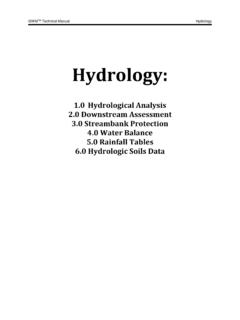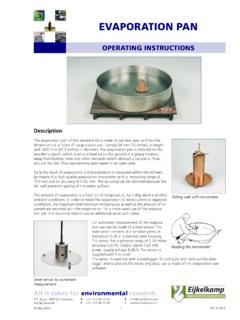Transcription of Basic Hydrology Time of Concentration Methodology
1 Basic Hydrology time of Concentration MethodologyBy: Paul Schiariti, , CPESCM ercer County Soil Conservation DistrictWhat is the time of Concentration ?The time it takes for runoff to travel from the most hydraulically distant point in the watershed to a point of is the most Hydraulically Distant Point in the watershed?Is it a hydraulic distance or a hydraulic time ?Is there a difference?Hydraulically Most Distant Point?Path A is 1000 ft. long with a time of Concentration = HoursPath B is 750 ft. long with a time of Concentration = HoursWhere is the Correct TC Flow Path?What is the difference in TCfor both Flow Paths?Path B TC= Hours, Path A TC= HoursWhat is the difference in QPEAKfor the two Flow Paths & which is correct?Approximately 9 Acres of the 10 Acres flows similar to Path B , therefore this path is representative of 90% of the drainage area, and realistically better represents the watershedThe use of TCFlow Path B represents an under-estimation of QPEAKby 19 to 20%.
2 Would this be an issue if it was the Pre-Development analysis?Three Components of the Segmental time of Concentration Flow: Sheet flow is flow over plane surfaces. It usually occurs in the headwater of streams. The most sensitive component of the TC. Pay very close attention to the Manning s Roughness Coefficient. Pay very close attention to the ground surface slope. The maximum sheet flow length should be no greater than 125 to 150 Concentrated Flow: After a maximum of 300 feet, sheet flow usually becomes shallow concentrated flow. Note: This 300 ft. value has since been revised down to a maximum of 150 ft. on very uniform surfaces. The latest version of WinTR-55 only allows up to 100 ft. of sheet Flow: Channel flow occurs within swales, channels, streams, ditches and piped storm drainage systems.
3 Velocities are computed for channel flow based upon Manning s open channel flow Segmental time of ConcentrationSheet FlowTravel time ComponentP2values are obtained from NRCS 24 Hour Design Storm Rainfall Segmental time of ConcentrationShallow Concentrated Flow and Channel Flow ComponentHow sensitive is the Sheet Flow equation to Manning s n ?Sheet Flow Equation:TT= (.007) x (n) (L) S Example:L = 125 = ft / ftLets say an n value of was mistakenly used when an n value of was the appropriate value. What effect will this have on the time of Concentration ? What effect will this have on the peak discharge rates? n = :TT= (.007) x ( ) (125) = Hours (Incorrect) n = :TT= (.007) x ( ) (125) = Hours (Correct) represents an under-estimation of the time of Concentration of 71%!
4 !!How does this effect the peak Discharge?Drainage Area = AcresRunoff Curve Number = 7410 Year Storm Precipitation = InchesAdditional Travel time for Shallow Concentrated Flow Plus Channel Flow = HoursTC1= Hours + Hours = HoursTC2= Hours + Hours = cfs (Incorrect) cfs (Correct)Difference in Peak Discharge Rates = cfsOver estimates the peak discharge by !!Effect on the Runoff Hydrograph for the different TC sNot only is the actual Peak Discharge the timing of the Peak Discharge is different as is the correct Manning s n value?ABManning s n for Maintained Turf Grass should almost always be = Increase In The Sheet Flow Travel time Related to Change In Ground Slope In %% Decrease In Sheet Flow TtAn over-estimation of ground slope from % to % results in an under-estimation in the Sheet Flow component of the time of Concentration by 25 %.
5 25 %Example time of Concentration Calculation10099989796959493929293939292 93949596979899"A"- "B"- "C"- "D"- Flow ShallowConcentrated FlowSheet Flow250 : The individual segment lengths are not the horizontal distances, but the linear distances along the flow path - the Sheet FlowTravel time Component of the time of Concentration : A B surface description best categorizes this type of ground cover for the purpose of choosing a Manning s n Roughness Coefficient ?10099"A "- "B "- Flow100 Manning s n value most closely mimics this specific ground cover?We can immediately eliminate the following:Smooth SurfacesFallow (No Residue)Cultivated SoilWoodsThis leaves the following choices:GrassRangeRange is defined as: An extensive tract of open land on which livestock wander and graze.
6 This is not a range !This leaves us with the grass options:Best fit is Dense Grasses n = the Sheet Flow Travel time Component:Sheet Flow Equation:TT= (.007) x (n) (L) S = 100 = ( )/ 100 = ft / ftn = (.007) x ( ) (100) = The next component of the time of Concentration is the shallow Concentrated flow Travel time Concentrated Flow Component of the time of Concentration1009997989"B"- "C"- S h a llo wConcentrated Flo wS125 ft. B C Concentrated Flow is 125 ft. (non-paved) at ( ) /125 = ft/ftEnter Figure 3-1 to arrive at the Average fpsTT= 125 / 3600 x = actual equation used to determine the velocity for Shallow Concentrated flow is based on:TT= L * (58, * ) -1-or-TT= L3600 x x : V = x Flow Component of the time of Concentration9897965959697"C"- "D"- Flow Con 250 ft.
7 C D Channel Slope is 250 ft. at ( )/250 = ft/ftNote: The channel does not have to possess a visible water surface to be considered channel Manning s equation to arrive at the Channel VelocityWow ! There are several unknown variables here. How are we going to assign values to them ?The first thing we need to know is the channel cross sectional ftAssume a reasonable flow depth say ft, and solve for the cross sectional flow area and the wetted channel geometryThe first step is to compute the Hydraulic Radius:Compute the Hydraulic Radius as follows:The Hydraulic Radius is equal to the cross sectional flow area divided by the wetted perimeter:A = ( ft. x ft.) + [( ft. x 2) x ft.] = = ft. + [2 x ( + )1/2] = = / ft.
8 = do we compute the Manning s n roughness coefficient?215 ftSUPPLEMENT A contained within Appendix A8 of the NJ STANDARDS entitled Method for Estimating Manning s n contains a practical Methodology based upon Cowan's Equation :n =(n0+ n1+ n2+ n3+ n4) x m5 Where:n= Manning s n valuen0= the portion of the nvalue that represents the channel materialin a straight, uniform smooth reach n1= the additional value added to correct for the effect of channel surface irregularitiesn2= the additional value for variations in shape and size of the channel cross sectionthrough the reach n3= the additional value forobstructions(such as beaver dams, debris dams, stumps, downed trees, and root wads extending into the channel) n4= the additional value for vegetationin the channel m5= the correction factor for the meanderingof the channel Method used to determine Manning s n value for earthen channels(Not to be confused with Manning s n for Sheet Flow)
9 Manning s n values to be used for Cowan s method for channel 1m5 Minor Degree of Very high High Medium n4 Low Vegetation Severe Appreciable Minor 0n3 Negligible Relative Effect of Alternating frequently occasionally 0n2 Gradual Variations of Channel Cross 0n1 Smooth Degree of Irregularity gravel gravel cut Material Involved Values Channel ConditionsCompute Manning s n value for the channeln0= Earth Channel = Smooth Irregularity = Gradual Section Variations = Negligible Obstructions = Low to Medium Vegetation = Minor Meandering = s n value = x = the Travel time for the channel sectionV = x R 2/3x S nV = x 2/3x = fps 250 / 3600 x = hoursThe total time of Concentration = TT1+ TT2+ TT3= TCTC = Hr.
10 + Hr. + Hr. = if our depth of flow assumption was incorrect?Lets say the actual flow depth was ft. as opposed to our original assumption of ft:A = ( ft. x ft.) + [( ft. x 2) x ft.] = = ft. + [2 x ( + )1/2] = = / ft. = = x 2/3x = fps 250 / 3600 x = hoursRemember our original TT was hours!!Really, not that much of a ftWhat is the correct Manning s n value for Sheet Flow ?Is this Fallow (no residue) or Cultivated Soils: Residue Cover < 20%; n = or ?What is the correct Manning s n value for Sheet Flow ?Cultivated Soils: Residue Cover > 20%; n = is the correct Manning s n value for Sheet Flow ?Smooth Surface (concrete, asphalt, gravel or bare soil); n = is the correct Manning s n value for Sheet Flow ?





